Introduction
Green technology refers to a type of technology that is considered environmentally friendly due to its manufacturing process or supply chain. Green technology is also called as clean energy. Traditional energy production and resource extraction methods have caused significant environmental damage, such as air and water pollution, deforestation, and climate change; the goal of green technology is to promote sustainability by reducing pollution, conserving resources, and reducing greenhouse gas emissions. This area includes innovations in renewable energy, energy efficiency, water purification, waste management, and sustainable transportation, among other things.
An Embedded System is an electronic system that combines computer hardware and software designed to perform a specific function. Embedded systems are used today to control numerous devices, from household appliances to complex industrial machines and automobiles, enabling automation and intelligence in these devices. They work silently in the background, managing processes, collecting data, and supplying connectivity.
Embedded systems are leading the green technology revolution, advancing the principles of reduce, reuse, and recycle. These principles are required to achieve sustainability, and embedded systems offer the intelligence and control necessary for their successful deployment in all industries. These systems, through intelligent control and real-time monitoring, help to reduce resource consumption, increase the life cycle of products, and improve recycling efforts, all of which are important for creating a sustainable future. Integrating embedded systems into green technology solutions can help the environment and save Mother Earth.
Let’s explore some Green Technology applications where embedded systems are making a major impact:
Smart Thermostat
A smart thermostat is a device that oversees the control of your home’s heating and cooling systems. Unlike typical thermostats, smart thermostats can learn your schedule, like when people are home or away, and preferences, and automatically adjust temperatures to save energy. Since they prevent unnecessary heating and cooling, smart thermostats can help save on energy and keep the environment more sustainable.
Smart thermostats are a prime example of how embedded systems are revolutionizing green technology; these systems combine sensors, micro-controllers, connection features, and specialized software to collect real-time data, analyze it, improve temperature settings, and enable remote control. With these components, embedded systems enable smart thermostats to offer intelligent features and reduce energy consumption while living green. Let us take an example to understand it better.
Example: Ecobee
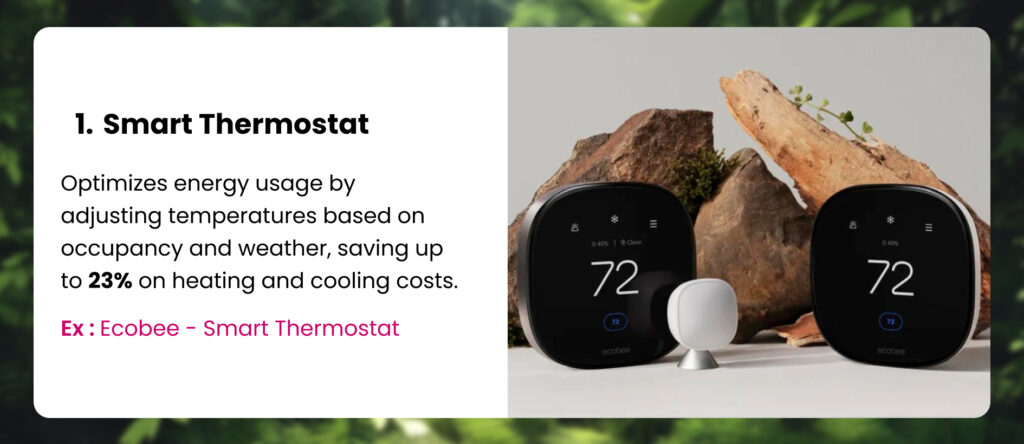
Ecobee is a leading manufacturer of smart thermostats that uses embedded systems to provide advanced features and energy-saving benefits such as learning your schedule, remote control via a smartphone app, and integration with smart home systems like Alexa and Google Assistant. These embedded systems allow Ecobee thermostats to collect sensor data, analyze information, and adjust temperature settings based on usage, weather conditions, and user preferences, ensuring comfort while reducing energy waste. This intelligent control helps reduce energy consumption, lower greenhouse gas emissions, and provide a more comfortable living environment, making it a smart and eco-friendly choice for modern homes.
Renewable Energy
Renewable energy refers to energy sources that are naturally restored and do not exhaust over time; embedded systems play a role in maximizing the efficiency and output of technologies like solar panels.These systems are designed to monitor and control multiple components of energy production.
For instance, in solar energy systems, embedded systems are responsible for tracking sunlight, adjusting solar panels, and managing power conversion processes. Embedded systems can increase energy production by up to 25% by continuously evaluating environmental conditions and improving solar panel performance. This can result in increased energy generation, reduced costs, and less environmental effect, all contributing to a more sustainable and independent energy future.
Example: Enphase
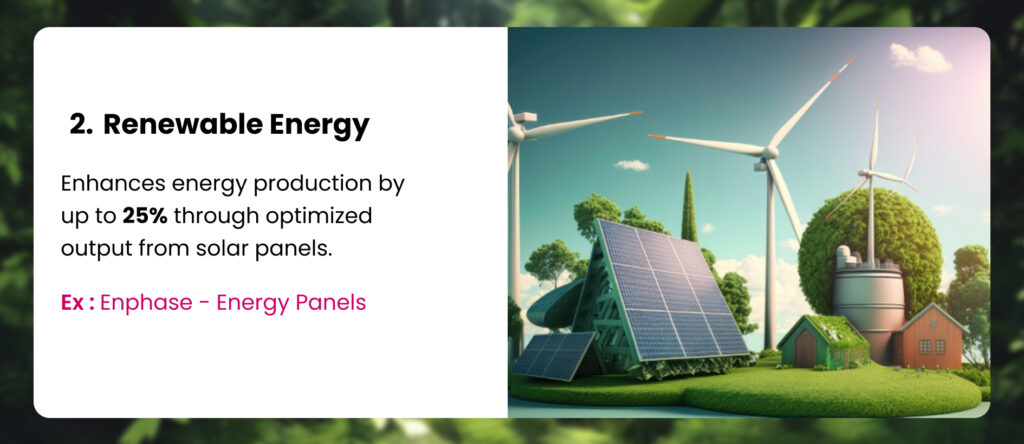
Enphase Energy is an energy technology company that designs, develops, manufactures, and markets energy solutions that manage energy generation and energy storage. Enphase microinverters are crucial components of solar energy systems, optimizing the performance of individual solar panels, unlike traditional inverters, which handle multiple panels that convert the power generated by an entire solar array. Enphase microinverters allows better energy management, maximizing energy production even in variable conditions like shading or dirt accumulation.
Enphase microinverters depend heavily on embedded systems to perform their functions effectively. Here’s an overview of how embedded systems work within Enphase products:
Panel-Level Monitoring and Control: Enphase microinverters use sensors to monitor characteristics such as Solar radiation, Temperature, Voltage, and current. The embedded system monitors the panel’s power output and environmental conditions, adjusting the energy conversion process to maximize efficiency.
Data Processing and Optimization: Embedded systems process real-time data from each solar panel, allowing the microinverters to adjust based on shadowing and temperature. This approach ensures that each panel operates at its peak performance, even if one or more panels are underperforming.
Communication and Integration: The embedded systems in Enphase microinverters communicate with a central gateway, to collect and transmit data. This cloud-based platform allows users to monitor energy production and system performance through real-time data analytics, resulting in better energy management insights.
By using embedded systems, Enphase ensures high efficiency, real-time monitoring, and improved reliability for solar energy systems, detecting faults or issues, saving downtime, and maintaining steady energy production, contributing to more sustainable and effective renewable energy solutions.
Electric Vehicles
Electric vehicles (EVs) are a huge progress in green technology, providing an alternative to traditional combustion engines due to their superior efficiency and reduced environmental effects. These motors can convert up to 85% of the battery’s energy into motion, compared to less than 40% in combustion engines. This improvement in energy conversion reduces overall energy consumption, reduces greenhouse gas emissions, and increases the range for EVs.
Embedded systems play a crucial role in enhancing the performance of electric vehicles. Here’s how embedded systems work within EVs:
Battery Management: The embedded system monitors the battery’s charge, voltage, and temperature, ensuring better performance and preventing overcharging or overheating. It also handles energy distribution, ensuring that the battery delivers power efficiently to the motor.
Motor Control Unit (MCU): The MCU controls the speed, torque, and efficiency of the electric motor. It uses embedded software to improve motor performance and reduce energy usage.
Safety and Performance Monitoring: These systems continuously monitor vehicle components, from sensors to controllers, improving real-time diagnostics and safety features. They support advanced driver assistance systems (ADAS) for a safer, more dependable driving experience.
Example: OLA Bikes
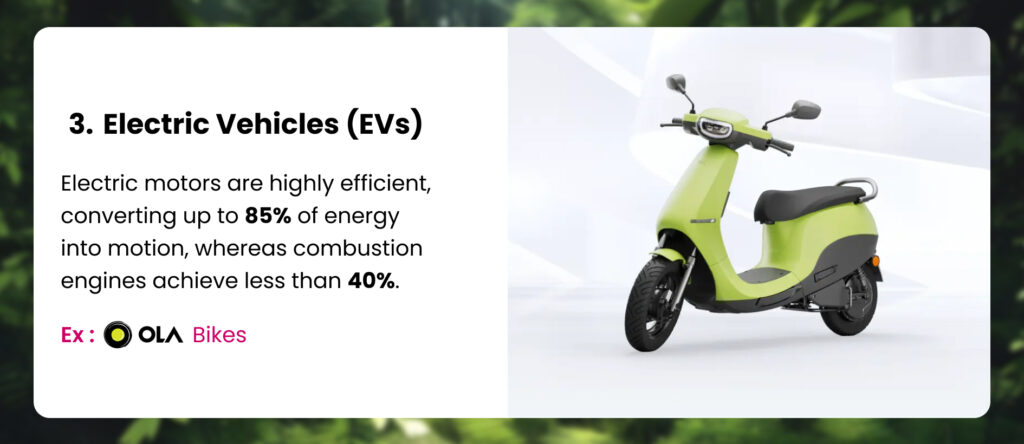
Ola Bikes is a great example of how embedded systems are revolutionizing electric vehicles. These two-wheeled electric vehicles rely on embedded technology to improve their performance, efficiency, and user experience. OLA’s electric bikes are powered by efficient electric motors, converting up to 85% of battery energy into motion, Embedded systems are important for the functioning of OLA bikes, managing battery performance, motor control, and energy optimization.
These systems monitor the bike’s battery health in real-time, ensuring appropriate charging and discharging cycles to increase battery life and improve range. Embedded systems also enable features like regenerative braking, which gathers energy during braking and uses it to recharge the battery. They contribute to the vehicle’s smart connectivity by allowing users to access real-time data, performance measurements, and ride statistics through mobile apps.
With embedded systems at its core, OLA Bikes offers a cleaner, more efficient, and technologically advanced alternative to traditional vehicles, aligning with the larger green technology goal of reducing carbon emissions and promoting sustainable transportation.
Environmental Monitoring
Environmental monitoring involves the systematic collection and analysis of data on environmental conditions, such as air quality, temperature, humidity, and pollutant levels. Embedded systems play an important role in environmental monitoring because they collect and analyze data in real-time to track critical environmental metrics such as air quality, temperature, humidity, and other climate indicators. These systems can be found in a variety of monitoring equipment, such as sensors and IoT platforms, which are used in urban areas, industrial zones, and natural environments.
Embedded systems allow for accurate tracking of pollutants like carbon dioxide, particulate matter, and nitrogen oxides, all of which are important for measuring air quality. They also monitor temperature and humidity levels to help in the study of climate patterns, which provides useful data for climate change studies. Because this monitoring is done in real-time, harmful pollutants can be detected right away, allowing for quick action to reduce environmental impact and protect human health.
Example: PurpleAir
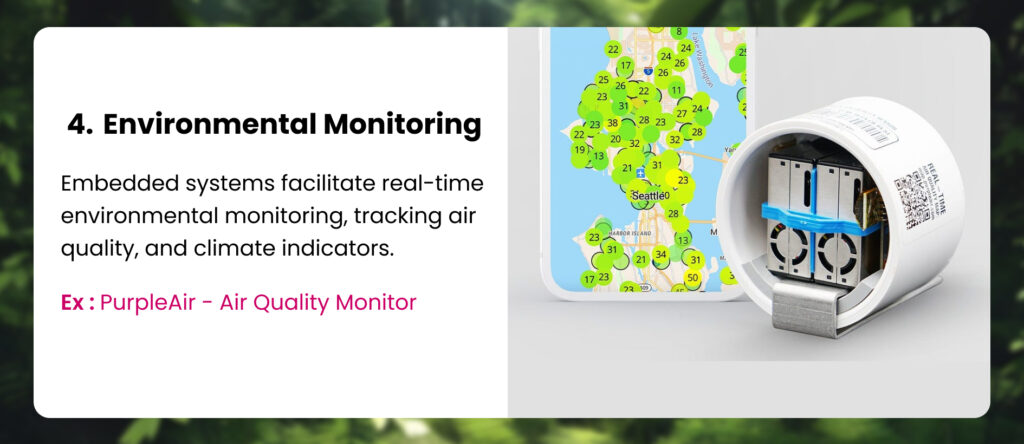
PurpleAir is an example of how embedded systems are revolutionizing environmental monitoring. These low-cost air quality sensors use embedded technology to offer real-time data on particle size, ozone, and other air pollutants. These sensors are installed in homes, schools, and communities creating a network of monitoring devices that provides local information on what’s happening nearby.
PurpleAir devices have embedded systems to perform a number of essential functions:
Data Recording: Embedded systems can record data from sensor components to detect particles and environmental conditions.
Real-Time Processing: It calculates pollution levels & air quality indexes in real-time, giving consumers immediate results on the local quality of the air.
Data transmission: The processed data is sent to the PurpleAir cloud platform and is displayed on public maps or available via mobile apps or websites. It allows users to keep an eye on real-time air quality in their surrounding area as well as the rest of the world.
Alerts And Responses: Embedded systems can also send automatic alerts when pollutant levels exceed a harmful limit, allowing communities or individuals to take preventive measures on time.
Waste Management
Smart Bins — Embedded systems are transforming waste management by increasing waste collection with smart bins. Introducing embedded systems in smart bins is revolutionizing waste collection and management. These dustbins come with smart programs with sensors that keep running and measure the waste flow. These systems monitor the fullness of bins to get a better idea of when waste should be collected and allow trucks to use this information by tracking how much trash there is so they do not have unnecessary trips.
In smart waste management, embedded systems play a critical role in optimizing the entire process. Here’s how they function:
Real-Time Monitoring: Embedded systems in smart bins use sensors to detect the fill levels of waste. These sensors continuously collect data on how much waste has been collected in each bin.
Data Processing and Communication: The embedded system processes this data and communicates it to a central system, often through wireless networks. This allows waste management teams to monitor the status of multiple bins across different locations in real-time.
Optimized Collection Routes: Based on the data received, the embedded system helps optimize waste collection routes. Trucks are dispatched only when bins are nearing capacity, reducing the number of unnecessary collection trips.
Fuel and Emissions Reduction: By ensuring that waste is collected only when necessary, embedded systems reduce the fuel consumption of collection vehicles, leading to lower emissions and more eco-friendly waste management practices.
In precise, embedded systems enable smart bins to improve waste collection, save resources, reduce fuel use, and minimize environmental impact.
Example: BigBelly
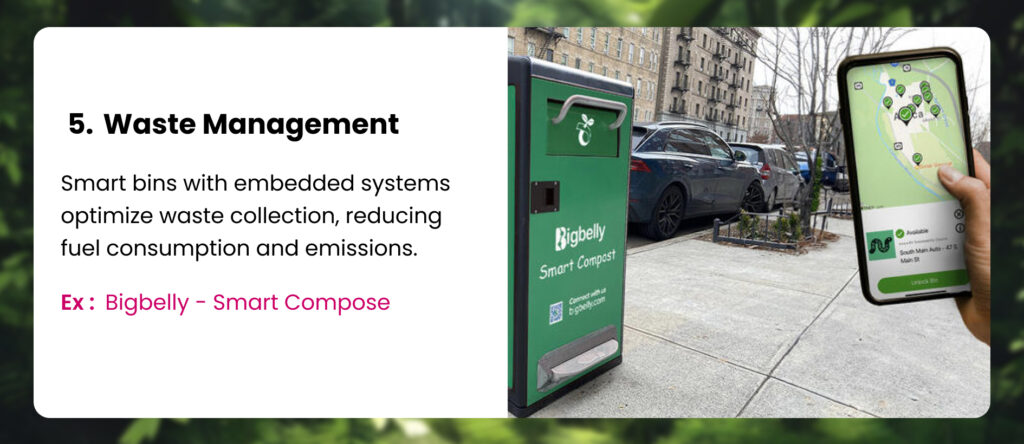
BigBelly’s Smart Compose system shows how the role of embedded systems is revolutionizing waste management. These smart waste bins contain embedded systems that monitor load levels in real-time, allowing for more effective waste collection. BigBelly bins not only detect waste levels but also compress them using solar-powered crushers, increasing each bin’s capacity by up to five times.
The embedded systems in BigBelly Smart Compose bins communicate with a central platform, providing real-time data to waste management teams. This allows for optimized collection schedules, ensuring that bins are only emptied when necessary, which reduces the time rate of collection trips. As a result, the system significantly cuts down on fuel consumption and lowers carbon emissions.
Conclusion
In conclusion, embedded systems are a driving force behind green technology innovations. They optimize energy use in smart thermostats like Ecobee, enhance solar efficiency in systems like Enphase, and improve battery management in electric vehicles like OLA Bikes. Embedded systems also enable real-time environmental monitoring through platforms like PurpleAir and streamline waste management with smart bins like BigBelly Smart Compose. By making these technologies more efficient and sustainable, embedded systems play a key role in reducing environmental impact and supporting a cleaner, greener future.
| Serial.No | Related Blogs | Link |
|---|---|---|
| 1 | The Future Scope of Embedded Systems : Trends and Predictions | Click Here |
| 2 | Embedded Course With Placements | Click Here |
| 3 | Introduction to Device Drivers in Embedded Systems | Click Here |
People Also Ask (PAA)
Embedded systems impact the green technology revolution by making technologies smarter, more efficient, and environmentally friendly. They optimize energy use in home automation, renewable energy, electric vehicles, environmental monitoring, and waste management. They are the key to achieving sustainability and reducing the environmental impact of human activities by reducing energy waste, lowering emissions, and improving resource efficiency.
Yes, embedded systems in Enphase microinverters allow each solar panel to work independently and adjust its output based on specific conditions. This micro-level control helps in energy production, allowing systems to generate more power than traditional devices, especially when some panels are shaded or dirty. This can result in an energy production boost of up to 25%.
The Challenges involved in using embedded systems in green technology are the complexity of designing and implementing, which requires specialized skills. Additionally, ensuring the stability and endurance of these systems in harsh environments is critical, and maintaining security to protect against cyber threats is essential to prevent data breaches and system disruptions.
